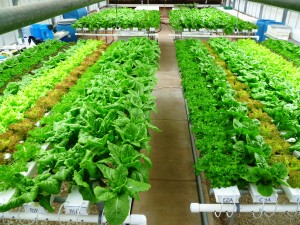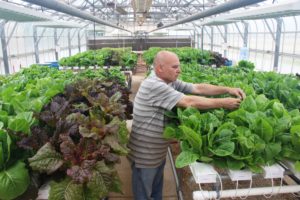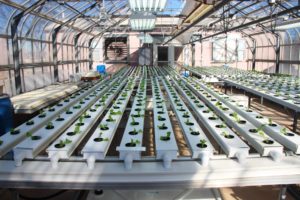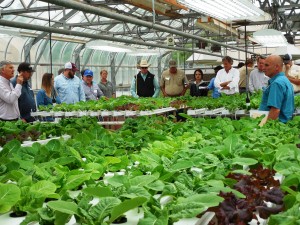Uvalde, Texas, USA
August 5, 2015
Even with the recent rains, vegetable producers in Southwest Texas know it’s just a matter of time before another drought.
VIDEO: Hydroponic Production of High-Value Lettuce Types
That’s why it is important to find alternative water-use efficient methods for growing vegetables, said Dr. Daniel Leskovar, director of the Texas A&M AgriLife Research and Extension Center in Uvalde. Recent research at the center studied hydroponic production of high-value lettuce cultivars using minimal water.

Twelve cultivars of bibb, loose-leaf and romaine lettuce were grown hydroponically at the Uvalde center using the nutrient film technique, or NFT. (Texas A&M AgriLife Research photo)
“Field production of vegetable crops in Southwest Texas is limited by strict regulations of water use for irrigation and by adverse environmental conditions such as drought and heat stress,” said Leskovar, also a Texas A&M AgriLife Research vegetable physiologist. “Because of this, the vegetable industry has been increasingly interested in maximizing water-use efficiency when growing premium leafy vegetables with consumer appeal.”
He said AgriLife Research has been collaborating with the Uvalde County Underground Water Conservation District on a grant from the Texas Department of Agriculture to study water-use efficiency and other aspects of high-value lettuce types.
“The Uvalde water district is our primary partner in this research and is instrumental in helping us with the direction of this study and in determining the use of the results,” Leskovar said.

Dr. Vasile Cerven examines one of the the lettuce varieties grown hydroponically at the Uvalde center. (Texas A&M AgriLife Research photo)
For the past few years, the center has been investigating the feasibility of hydroponically growing vegetables in Southwest Texas. Most recently, investigations by Leskovar and Vasile Cerven, an AgriLife Research postdoctoral researcher in vegetable physiology at the Uvalde center, have focused on the growth and evaluation of 12 types of high-value lettuce.
“We chose the nutrient film technique, or NFT, of hydroponics for the research,” Leskovar said. “This technique is very water-use efficient and allowed us to grow the lettuce in a controlled environment — in this case, one of the center’s greenhouses.”
He said this technique uses about 10 percent of the water normally used in an open field and provides sustainable production for the lettuce types selected for the study.
NFT uses a shallow stream of water containing dissolved nutrients for plant growth. The water recirculates past the bare roots of plants in a watertight channel. It allows the root mat or cluster, which develops in the bottom of the channel, to have a moist upper surface exposed to the air.

The lettuce varieties were grown using nutrient-rich water recirculating over their roots in a watertight channel system. (Texas A&M AgriLife Research photo)
“The objective of this study was to evaluate water-use efficiency, growth and quality of bibb, loose-leaf and romaine lettuce types over three production cycles in a recirculating hydroponic system,” Leskovar said.
Cerven said the research showed how efficiently lettuce types may be grown under controlled conditions, such as a greenhouse or high-tunnel enclosure.
Bibb lettuce types selected for the research were buttercrunch and bibb. Among the loose-leaf types, Caipira, Ezatrix, Ezfrill, Exfilan, Kremlin Red Leaf, Pearl Gem and Progreen 76 were selected. Among romaine lettuce types, Sunbelt and Chabi were chosen.
“We selected these lettuce types for study not only because they are high-value crops, but also because we wanted to learn more about them to make recommendations to industry producers as to which also might be more resistant to nutritional deficiencies and also diseases,” Cerven said.
Seedlings were grown in 98 cell rockwool slabs in trays in greenhouse conditions. Three weeks later, those young transplants were placed 8 inches apart into the recirculating hydroponic NFT channels containing a nutrient solution. Crops were harvested in three cycles in December, 2014, and February and March, 2015. Measurements were taken of the fresh and dry weight of the leaves, the number and strength of the leaves, stem diameter, chlorophyll content and water use efficiency, noted as WUE.
“Another benefit of this type of hydroponic production is that the lettuce plants were able to grow more quickly – they had about a 55-day growing cycle, as compared to about 100 days if planted from seed into the soil,” Leskovar said. “And since this can be done in a controlled environment like a greenhouse, this also will allow producers to grow these high-value lettuce plants significantly beyond the normal outdoor growing season.”

Producers from the Texas Winter Garden region and the surrounding area look at the lettuce grown at the center. (Texas A&M AgriLife Research photo)
Results from the study showed buttercrunch proved to be the better of the bibb-type lettuces with the best water use efficiency of all cultivars and 1.6 times higher productivity — plant weight, number and weight of leaves — than bibb. Among the romaine types, Sunbelt was found to have both a better water use efficiency and a higher productivity level than the Chabi cultivar.
In the largest group studied, the loose-leaf lettuces, Pearl Gem had the best water use efficiency and was the most productive. Caipira, Ezatrix, Kremlin Red Leaf and Progreen 76 had a mid-range WUE and moderate productivity, while Bellatrix, Ezfrill and Ezfilan cultivars had poor WUE and the lowest productivity of all lettuce types grown in the system.
Bibb, buttercrunch, Sunbelt and Chabi cultivars also showed moderate leaf “tip burn” injury during the first cycle.
“A number of lettuce varieties get what is commonly called tip burn, which is a symptom of a calcium deficiency in the leaves,” Leskovar said. “It is a physiological disorder that makes the tips of the leaves brownish and shriveled, as though they had been burned.”
He said screening and selection of lettuce cultivars for reduced leaf tip burn, high water use efficiency and leaf quality in hydroponic culture is important to improve water productivity, extend the production season and improve product quality with minimum use of pesticides and nitrates.
“This study shows it is possible to effectively grow high-value, good-quality lettuce under controlled hydroponic conditions using 85 to 90 percent less water than traditional soil-based production,” Leskovar said.